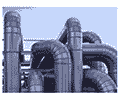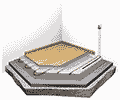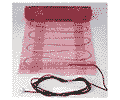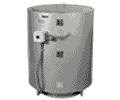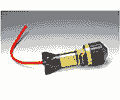Optical fiber and cable standards
Leading standardization bodies for:
Fibers:
ITU-T SG15:
- G650 test method series
- G651 multimode 50/125 μm
- G652 dispersion unshifted singlemode optical fiber
- G653 dispersion shifted singlemode optical fiber
- G654 cut-off shifted singlemode optical fiber
- G655 non-zero dispersion-shifted singlemode optical fiber
- G656 non-zero dispersion-shifted singlemode fiber for wideband optical transport
- G657 bending loss insensitive singlemode optical fiber
- Recent changes seen in G657 for low bend loss fibers
- FO Cables: IEC SC86A
- 60793 series for fibers
- 60794 series for cables
- Recent changes seen in patchcord cables IEC 60794-2-50
Low Optical Bend Loss Fibers
Why needed?
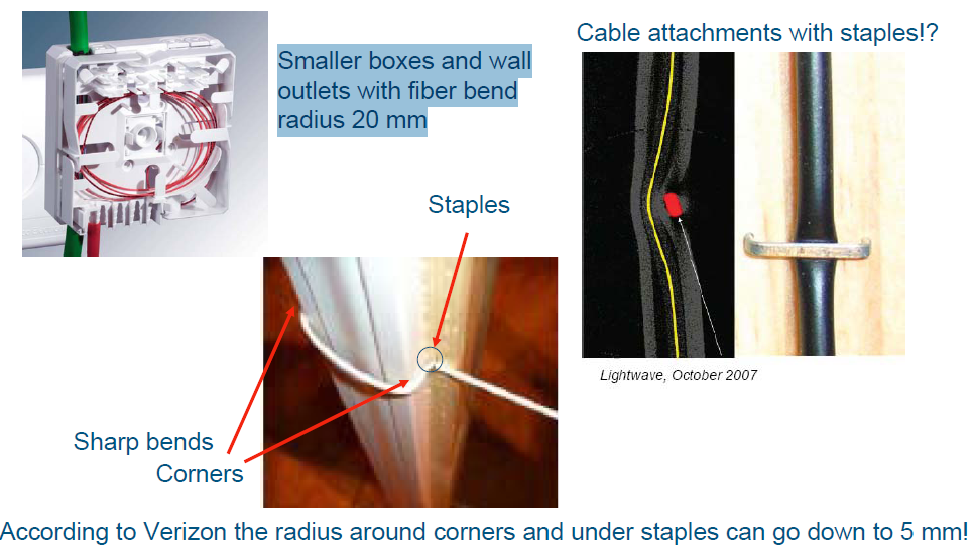
Bending loss performance of standard singlemode fiber (ITU-T G. 652D)
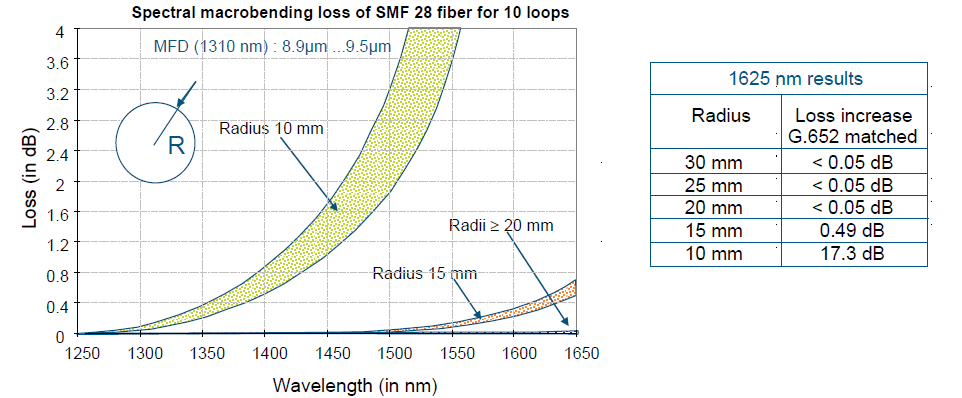
Observations:
- Loss becomes important once bending radius becomes smaller than 20 mm
- Splicing trays with 25 mm and 30 mm bending radius will not affect transmission at 1625 nm in G. 652D fibers
- In some limited cases (max 2 meter) a 20 mm radius is allowed (see ITU-T L13 and IEC 61756)
Low Optical Bend Loss Fibers
The traditional ITU-T G. 652D singlemode fiber Matched cladding
General:
Optimized bandwidth for 1310 nm transmission
(= Minimum chromatic dispersion at 1310 nm)
Lowest attenuation at 1550 nm
 Characteristics:
Characteristics:
Mode field diameter at 1310 nm: 9.2 μm ± 0.4 μm
Mode field diameter at 1550 nm: 10.4 μm ± 0.5 μm
Cladding diameter: 125 μm ± 0.7 μm
Mode field concentricity error: 0.5 μm @ 1310 nm
1550 nm loss performance: < 0.05 dB for 100 turns
on 50 mm mandrel diameter
Chromatic dispersion: 3.5 ps/(nm.km) @ 1310 nm
18 ps/(nm.km) @ 1550 nm
Proofstress strain test: 1%
Attenuation: <0.35 dB @1310 nm and <0.25 dB @ 1550 nm
Non colored coating diameter: 245 μm ± 10 μm
Colored coating diameter: 250 μm ± 15 μm
General:
Optimized bandwidth for 1310 nm transmission
(= Minimum chromatic dispersion at 1310 nm)
Lowest attenuation at 1550 nm
Characteristics (not up-to-date!):
Mode Field Diameter at 1310 nm: 8.8 μm±0.5 μm
Mode field diameter at 1550 nm: 9.7 μm ± 0.6 μm
Cladding diameter: 125 μm ± 1.0 μm
Mode field concentricity error: 0.8 μm @ 1310 nm
PMD (fiber): 0.5 ps/ km at 1310 nm
Chromatic dispersion:
18 ps/(nm.km)at 1550 nm
1550 nm loss performance: < 0.1 dB for 100 turns
on 75 mm mandrel diameter
Proofstress strain test: 1%
Attenuation: <0.4 dB @1310 nm and <0.3 dB @ 1550 nm
Non colored coating diameter: 245 μm ± 10 μm
Colored coating diameter: 250 μm ± 15 μm
Low Optical Bend Loss Fibers
How can you improve the bending loss performance?
Light in a waveguide is better “contained” when the difference of refractive index between the core and cladding is increased.
This results in a better bend loss performance, but it will result in a lower bandwidth or transmission capacity (modal dispersion, higher chromatic dispersion)
Different low microbend loss fiber types
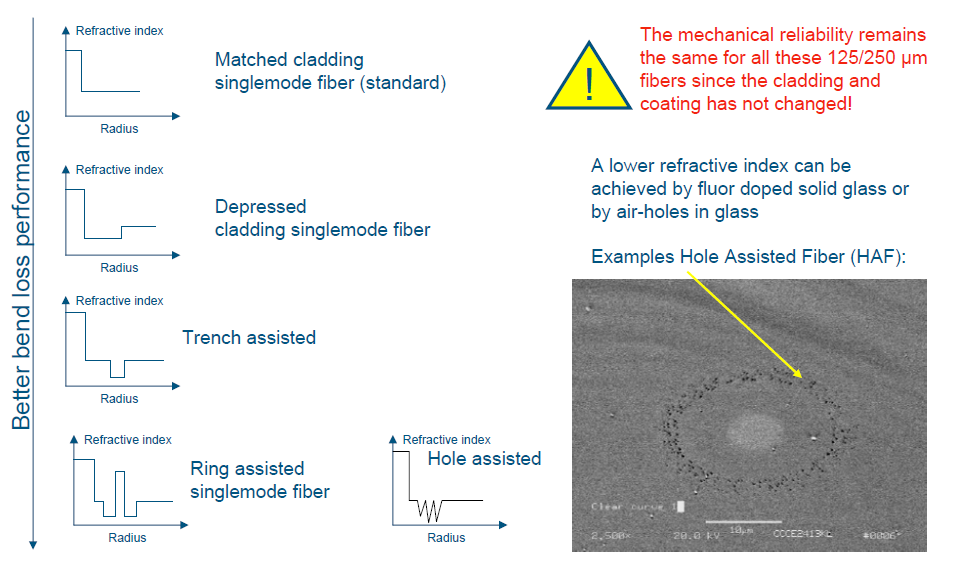
ITU-T G. 657 recommendation
- ITU has published in Dec 2006 a recommendation for such fibers:
- ITU-T G.657A fiber: These are G. 652D fibers with tighter dimensional tolerances that will result in a better optical performance during bending. These fibers are also known as Low Macrobend Loss fibers. The specified minimum bending radius for optical attenuation is 10 mm. Roughly 10 times better bending performance than traditional single-mode fiber
- ITU-T G.657B fiber: Fibers designed to have a very low loss during bending, but they are not always compatible with the G. 652 fibers anymore and therefore restricted to shorter distances (associated with indoor cabling). These fibers can have connection and splicing problems for some types. These fibers are typically called Bend Tolerant Fibers. The specified minimum bending radius for optical attenuation is 7.5 mm. Roughly 100 times better bending performance than traditional single-mode fiber.
Different commercial available brand names
- Corning: RC HI 1060 Flex
- Corning: RC-SMF 28 with reduced cladding diameter (80 μm)
- Sumitomo: Pure access ultra
- Mitsubishi cable: Diaguide PCF (holey fiber type)
- OFS F900x series
- Nufern 1550-HP
- Corning SMF28e+
- Corning SMF28-XB
- Draka Comtec: BendBright
- Draka Comtec: BendBright XS
- OFS Allwave Flex
- Corning Clearcurve
- OFS EZ Bend
…. Many more …
Low Optical Bend Loss Fibers
Experimental data from Tyco Electronics
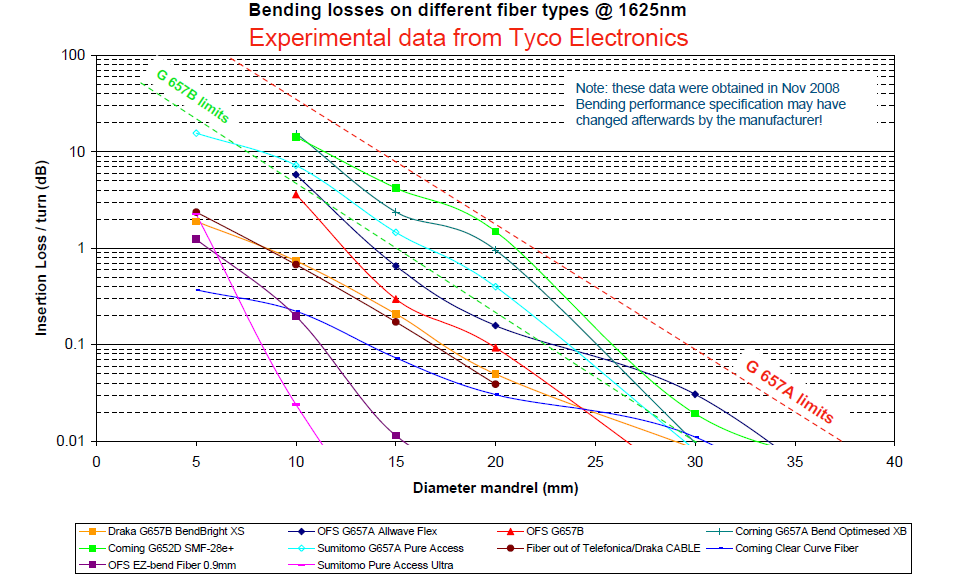
Specified bending losses for ITU-T G.652 and G.657 fibers
.png)
But after 2006, fiber manufacturers have developed fiber types that even exceeds the bending loss performance of the G.657B! A minimum bending radius of 5 mm is possible without significant optical loss! Such fibers can be called a true Bend Insensitive Fiber.

